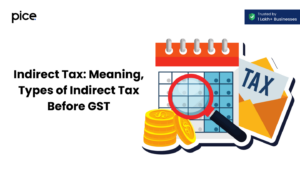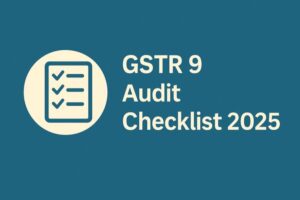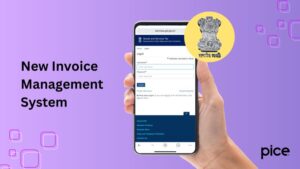How to File B2C in GSTR 1 in India?
- 18 Aug 24
- 24 mins

How to File B2C in GSTR 1 in India?
- Latest Updates in Form GSTR-1
- Using Gen GST Software for GSTR-1 Filing
- Quarterly Filing GSTR 1 Without IFF Filing
- Liability Statements in GSTR-1
- NIL Statement Filing with the CBIC for GSTR-1
- Salient Features of the GSTR-1 Return Form
- Eligibility: Who Should File GSTR-1?
- Deadlines for Return Filing of GSTR-1
- Consequences of Late GSTR-1 Filing
- Common Errors to Avoid in GSTR-1 Filing
- Conclusion
Key Takeaways
- Accuracy is Crucial: Ensuring that all data entered in GSTR-1, including invoice details, HSN/SAC codes, and business transactions, is accurate is vital to maintaining compliance and avoiding potential penalties or mismatches in the GST system.
- Timely Filing: Adhering to the filing deadlines for GSTR-1 prevents late fees and interest charges. Staying organized with a clear schedule for GST obligations helps businesses maintain good standing and ensure smoother operations.
- Comprehensive Reporting: It is important to report all types of transactions, including nil-rated, exempt, and non-GST supplies, as well as adjustments from previous periods. This comprehensive reporting aids in clear financial documentation and smoother audits.
- Reconciliation Practices: Regular reconciliation of sales ledgers and GST filings, such as GSTR-1 and GSTR-3B, is necessary to catch discrepancies early and rectify them before they lead to compliance issues.
GSTR-1 is a monthly or quarterly return that every registered dealer needs to file. It contains details of all outward supplies, i.e., sales. Understanding the correct filing procedure and compliance requirements is crucial for maintaining accurate GST records.
Latest Updates in Form GSTR-1

The latest updates in Form GSTR-1 are significant for all GST-registered businesses, as they directly impact the filing process and compliance requirements. Let’s explore these updates in detail to ensure you can seamlessly integrate these changes into your GST filing practices.
- Introduction to Optional Invoice Filing Using the Invoice Furnishing Facility (IFF): The GST Council introduced the IFF for taxpayers under the QRMP (Quarterly Return Monthly Payment) scheme. This optional feature allows businesses to upload their B2B sales invoices every month, even though the GSTR-1 return is filed quarterly. This helps in faster ITC (Input Tax Credit) availability to recipients.
- Auto-Population of Details: Significant strides have been made in making the GSTR-1 filing more efficient through auto-population. Now, details from the taxpayer’s e-way bills are auto-populated into the GSTR-1 form. This reduces the filing burden and decreases the possibility of data discrepancies between e-way bills and the GSTR-1.
- Amendment in Reporting of B2C (Large) Invoices: For businesses with a turnover exceeding Rs 5 crores, the reporting of B2C (Large) invoices has been streamlined. The invoice matching mechanism has been enhanced, ensuring that inaccuracies are minimized and compliance is bolstered.
- Enhanced Flexibility in Reporting HSN/SAC Codes: The requirement for reporting HSN (Harmonized System of Nomenclature) or SAC (Services Accounting Code) codes has been revised. Taxpayers now have increased flexibility depending on their aggregate turnover, which simplifies the compliance process while ensuring the necessary details are adequately reported.
- Introduction to Quarterly Filing of GSTR-1 Without IFF for Small Taxpayers: Small taxpayers with an annual aggregate turnover up to Rs 5 crore now have the option to file their GSTR-1 report on a quarterly basis without the need for monthly IFF submissions. This reduces the compliance load on small businesses, allowing them to focus more on their operations.
- Adjustments for Past Period Details: GSTR-1 now allows for adjustments related to past tax periods, which can include amendments in sales details or adjustments for earlier tax errors. This is particularly beneficial for businesses that need to correct previously filed returns without complicating their current period filings.
Using Gen GST Software for GSTR-1 Filing
- Automated Data Import: Gen GST Software allows users to seamlessly import data from various formats like Excel or CSV, directly into the software. This reduces manual entry errors and saves valuable time.
- Real-Time Error Detection: The software is designed to identify common errors during the entry of data. This feature helps in correcting mistakes before filing, ensuring that the returns are accurate and compliant with GST regulations.
- Integrated E-Way Bill Generation: Gen GST Software provides an integrated platform to generate e-way bills alongside the GSTR-1 filing. This integration ensures that all outward supplies are matched with corresponding e-way bills, thus maintaining consistency across records.
- One-Click Return Filing: With Gen GST Software, GSTR-1 filing becomes a one-click process once all data is validated and finalized. This not only speeds up the process but also helps meet filing deadlines effortlessly.
- HSN/SAC Lookup: The software includes a built-in HSN/SAC code lookup tool that helps users find the correct codes for their goods or services quickly. This feature is essential for accurately categorizing items in the GSTR-1 return.
- Multi-GSTIN Management: For businesses operating in multiple states or having more than one GST registration, Gen GST Software allows managing multiple GSTINs from a single dashboard. This centralization makes it easier to handle filings for multiple branches or divisions efficiently.
- Amendment Returns: If there's a need to revise previously filed returns, Gen GST Software facilitates the filing of amendment returns. It helps track changes and ensures that all amendments are accurately reflected in the subsequent GSTR-1 filings.
- Comprehensive Reports: The software provides detailed reports on GSTR-1 filings, including status reports, validation errors, and other essential analytics that aid in maintaining records and preparing for future tax periods.
- Cloud-Based Security: As a cloud-based solution, Gen GST Software ensures that all data is securely stored and backed up in the cloud. This provides businesses with the assurance that their financial data is safe and accessible from anywhere at any time.
- User Support and Compliance Updates: Gen GST Software has a skilled technical support team that can help with any GSTR-1 filing-related issues. Additionally, the software is regularly updated to reflect the latest GST rules and changes, ensuring compliance is always up-to-date.
Quarterly Filing GSTR 1 Without IFF Filing
By opting for quarterly GSTR-1 filing without IFF, smaller businesses can significantly reduce their monthly compliance workload while still meeting all regulatory requirements. This method not only streamlines the administrative processes but also ensures that businesses remain compliant with GST laws in a more manageable way.
- Overview of Quarterly Filing Without IFF: Under the QRMP (Quarterly Return Filing and Monthly Payment) scheme, small taxpayers with a turnover up to Rs. 5 crore can opt to file their GSTR-1 return quarterly instead of monthly. This option eliminates the need for monthly IFF (Invoice Furnishing Facility) filings, simplifying the GST compliance process and reducing the administrative burden on small businesses.
- Credit Notes: When filing GSTR-1 on a quarterly basis without using IFF, businesses must include all credit notes issued during the quarter. These notes are adjustments against earlier invoices and need to be reported in the same quarter they are issued. This helps in the accurate reconciliation of returns and ensures that the GST liabilities are adjusted accordingly.
- Inter-State Supplies: Even in a quarterly filing setup without IFF, details of all inter-state supplies made to unregistered persons (B2C transactions) or supplies under the composition scheme must be reported. This is crucial for correct tax attribution between states and proper management of input tax credits.
- Involvement of Unregistered Persons: The quarterly GSTR-1 filing includes details of supplies to unregistered persons. This involves reporting all sales transactions where GST was collected but the buyer did not have a GST registration. This data helps the government track the flow of goods and ensure tax compliance from all parties involved in the supply chain.
- B2B Supplies: For businesses making B2B supplies, reporting in the quarterly GSTR-1 becomes particularly important as it impacts the input tax credit chain. Even without monthly IFF filings, all B2B invoices must be thoroughly documented and reported in the quarterly GSTR-1 to ensure that the recipients can claim their input tax credit without any hindrance.
- Handling of Tax Invoices and Amendments: All tax invoices, along with any amendments or modifications from the previous periods, should be included in the quarterly filings. This ensures that all transaction records are up-to-date and reflect accurate tax liabilities or credits.
- Non-GST and Exempt Supplies: Reporting of non-GST and exempt supplies remains a crucial element of the GSTR-1 quarterly filing. These entries are essential for maintaining proper tax records and for compliance with GST regulations, ensuring that all types of transactions are accounted for in the periodic GST returns.
- Compliance and Record Keeping: Even with the simplified quarterly filing process without IFF, maintaining detailed records and compliance documentation is vital. This includes preserving invoices, credit/debit notes, and adjustment records, which could be required for future audits or compliance checks by tax authorities.
Liability Statements in GSTR-1
- Purpose of Liability Statements: Liability statements in GSTR-1 are critical for summarizing the taxpayer's GST obligations based on the transactions reported during the tax period. These statements provide a consolidated view of the taxes due, taking into account various types of supplies, including inter-state, intra-state, and exports.

Components of Liability Statements: A typical liability statement in GSTR-1 includes:
- Taxable Outward Supplies to Registered Persons (B2B): This includes all the supplies made to other GST-registered businesses. The details must include GSTIN of the recipient, invoice value, and tax charged.
- Taxable Outward Supplies to Unregistered Persons (B2C): These are the supplies made to consumers and entities not registered under GST. Details required include total sale value and tax amount.
- Exports of Goods and Services: All export transactions should be reported here with details like invoice values and any tax applied if not under LUT (Letter of Undertaking).
- Adjustments for Previous Tax Periods: Any adjustments or amendments to past invoices are also reported in the current period's liability section.
- Credit/Debit Notes Issued: If there have been returns or corrections to previously issued invoices, these must be included. They adjust the tax liability accordingly.
- Calculation of GST Liability: The total GST liability is calculated by aggregating the tax amounts from various sections of the GSTR-1. This includes CGST, SGST/UTGST, and IGST, depending on the nature of the supply (inter-state or intra-state).
Importance of Accurate Reporting: Accurate filling of the liability statement is crucial for several reasons:
- Compliance: It ensures compliance with GST laws and avoids legal repercussions, including penalties for under-reporting.
- Input Tax Credit Reconciliation: It helps in the reconciliation of input tax credits for your buyers, as they rely on the accuracy of your GSTR-1 for their GSTR-2A/2B.
- Financial Planning: Accurate tax liability statements help in better financial planning and cash flow management for businesses.
Common Errors to Avoid
- Mismatch in Invoices: Ensure that all invoices reported match those in your accounting software to avoid discrepancies.
Incorrect HSN/SAC Codes: Using incorrect codes can lead to a miscalculation of tax liabilities.
Delayed Reporting of Amendments: Any amendments to previous periods should be reported timely to avoid cumulative errors in subsequent filings. - Using Software Tools: Leveraging advanced GST software can help automate the preparation of liability statements, reduce errors, and ensure compliance. These tools can integrate with accounting systems to pull data directly, ensuring that the GSTR-1 file is accurate and comprehensive.
NIL Statement Filing with the CBIC for GSTR-1
Businesses that have not conducted any taxable transactions during a period can file a NIL GSTR-1. This is done through the CBIC’s portal and is a straightforward process if there are no transactions to report.
What is a NIL GSTR-1 Statement?
- A NIL GSTR-1 statement is filed when a registered taxpayer has no taxable sales, no outward supplies, and no credit/debit notes to report for a specific tax period. This is common for businesses that may not have had any sales activity or taxable transactions in a given month or quarter.
Eligibility for Filing NIL GSTR-1
Any registered person under GST can file a NIL GSTR-1 if they meet the following conditions:
- No supplies (taxable or non-GST) were made during the period.
- No receipts of goods or services which require a reverse charge.
- No other liability (like late fees) that needs to be reported.
Procedure for Filing NIL GSTR-1
- Login to GST Portal: Begin by logging into the GST portal using your 15-digit PAN-based GSTIN.
- Navigate to GSTR-1 Form: Select the GSTR-1 form for the relevant tax period.
- Verification of Details: Ensure that all sections of the GSTR-1 form related to taxable supplies, interstate supplies, B2C supplies, and others are zero or not applicable.
- Submit the Form: Once confirmed, submit the NIL return. An acknowledgment number will be generated upon successful submission.
Advantages of Filing NIL GSTR-1
- Compliance Maintenance: Keeps your GST compliance status up-to-date, avoiding penalties for non-filing.
- Ease of Filing: NIL returns are simpler to file as they require minimal entries and no detailed invoice reporting.
- Record Maintenance: Helps maintain continuous records on the GST portal, which is beneficial during audits or inspections.
Common Mistakes to Avoid
- Ignoring Filing: Failing to file GSTR-1 because there were no transactions. Even if there are no transactions, a NIL return must be filed.
Incorrect Reporting: Ensure that no taxable supplies were made before filing a NIL return. Accidentally filing a NIL return when there were taxable supplies can lead to penalties and interest for under reporting. - Impact of Non-Filing: Not filing a GSTR-1 return, including a NIL return, can lead to late fees and penalties. It also affects the compliance rating on the GST portal, which can have longer-term implications for business credibility.
- Using GSTR-1 Data for Future Periods: While a NIL return indicates no activity for the period, the data remains integral to your overall GST records. Ensure consistent filing practices to support seamless future tax periods, facilitating easier cumulative assessments or adjustments
Salient Features of the GSTR-1 Return Form

The GSTR-1 form is designed to capture comprehensive details about all outward supplies. The salient features of the GSTR-1 return form, particularly emphasizing how it handles B2B transactions and other key elements:
Comprehensive Transaction Reporting:
- B2B Transactions: Detailed reporting of all business-to-business transactions, ensuring transparency and accuracy in input tax credit claims by recipients. Each B2B invoice must include GSTIN of the buyer, invoice number, date, value of goods/services, tax rate applied, and the tax amount charged.
- Exports and Deemed Exports: Specific sections for reporting exports under various schemes, including supplies with payment of tax and supplies under bond or Letter of Undertaking (LUT). Export invoices should detail the value of goods/services exported, GST paid, if any, and the shipping bill details.
- Inter-State and Intra-State Supplies: Separate disclosure requirements for supplies made within the state (intra-state) and supplies to other states (inter-state) to ensure proper allocation and compliance with tax regulations.
Dynamic Invoice Reporting
- Invoice-Level Details: Each taxable invoice is reported in GSTR-1, providing a clear trail of outward supplies, which aids in the reconciliation of input tax credits (ITC).
- Credit and Debit Notes: Adjustments made to previously reported invoices due to returns, discounts, or corrections are reported in this section, which impact the net taxable value and tax payable.
- Amendment Sections: Any amendments to previously filed returns can be corrected in the subsequent periods through the amendment sections of the GSTR-1.
HSN/SAC Summary
- To facilitate the classification of goods and services, the GSTR-1 form requires the HSN (Harmonized System of Nomenclature) code for goods and the SAC (Services Accounting Code) for services. This helps standardize reporting across different sectors and simplifies tax administration.
Enhanced Compliance Features
- Real-Time Data Sharing: The information filled in GSTR-1 is immediately available to the recipient in their GSTR-2A/2B, which helps in the real-time reconciliation of input tax credits.
- Automation: The GSTR-1 form can be auto-populated using data from the e-way bill system and other integrated tools, reducing manual data entry and the potential for errors.
Multiple Filing Options
- Depending on the business's turnover and preference, GSTR-1 can be filed either monthly or quarterly, providing flexibility in compliance and cash flow management.
Nil-Rated, Exempt, and Non-GST Supplies
- Specific sections in GSTR-1 allow for the reporting of nil-rated, exempt, and non-GST supplies to ensure complete disclosure of all types of sales, even those that do not attract GST.
Refund Vouchers and Advance Receipts
- For advances received for which invoices are not issued in the same tax period, reporting in GSTR-1 ensures that GST liabilities are recognized in the period the advance is received. Refund vouchers for advances on which GST was paid but later refunded are also reported.
Regular Updates and Customizations
The GST portal regularly updates the GSTR-1 form to incorporate changes in tax laws and user feedback, making the system responsive to the needs of taxpayers and evolving regulatory requirements.
Eligibility: Who Should File GSTR-1?
- Registered GST Taxpayers
All businesses registered under GST are required to file GSTR-1, except those who are opted into special schemes like the GST Composition Scheme.
- Based on Annual Turnover
- Regular Taxpayers with Turnover Above Rs. 1.5 Crores: Required to file GSTR-1 on a monthly basis.
- Taxpayers with Turnover Up to Rs. 1.5 Crores: Have the option to file quarterly returns under the QRMP (Quarterly Return Monthly Payment) scheme.
Type of Supplies
Taxpayers need to report all types of outward supplies, including:
- B2B (business-to-business) Transactions: All taxable supplies made to other registered businesses.
- B2C (business-to-consumer) Transactions: Supplies made to consumers and unregistered businesses.
- Exports and Zero-Rated Supplies: Supplies to customers outside India or SEZs (Special Economic Zones).
- Nil-Rated, Exempt, and Non-GST Supplies: All sales that do not attract GST must also be reported.
Inter-State and Intra-State Supplies
- Details of both inter-state (across state borders) and intra-state (within the same state) supplies need to be separately reported in GSTR-1.
Invoices Detailing
- Every invoice, credit note, debit note, and revised invoice related to outward supplies must be reported in GSTR-1.
Input Service Distributors
- Although primarily dealing with the distribution of input tax credits, Input Service Distributors (ISDs) also need to comply with GSTR-1 filing requirements for any outward supplies they make.
Special Cases
- Casual Taxable Persons: Those who occasionally undertake transactions involving the supply of goods and/or services in a territory where GST is applicable but do not have a fixed place of business. They are treated as casual taxable persons and must file GSTR-1.
- Non-Resident Taxable Persons: Those who reside outside India but supply goods or services to recipients in India must file GSTR-1.
Filing Period and Deadlines
Monthly Filers: By the 11th of the following month.
Quarterly Filers (QRMP Scheme): By the 13th of the month following the quarter.
Deadlines for Return Filing of GSTR-1

The deadlines for GSTR-1 filing depend on turnover and the chosen scheme (monthly or quarterly). Missing these deadlines can result in penalties and affect the compliance rating of a business.
GSTR-1 IFF Under QRMP Scheme: Due Dates
The due dates and requirements for filing GSTR-1 under the QRMP (Quarterly Return Monthly Payment) scheme, focusing on the Invoice Furnishing Facility (IFF) and its relevance to maintaining updated business transactions.
- The QRMP Scheme: The QRMP scheme allows small taxpayers with an annual turnover of up to Rs. 5 crores to file their GSTR-1 returns quarterly while paying their taxes monthly. This scheme aims to reduce the filing burden and enhance cash flow management for smaller businesses.
Role of Invoice Furnishing Facility (IFF)
- The IFF allows taxpayers under the QRMP scheme to upload their B2B invoices for the first two months of each quarter. This is optional but beneficial because it helps their recipients claim input tax credit (ITC) timely.
- By using the IFF, businesses can ensure that while their GSTR-1 filing is quarterly, the tax credits available to their clients are not delayed, thereby maintaining business efficacy and compliance.
Due Dates for IFF
For each of the first two months of the quarter, the due date for uploading invoices through the IFF is the 13th of the following month. For example, for invoices issued in January (Q4 of FY), the due date for uploading them in the IFF would be February 13th.
Filing GSTR-1 Under QRMP Scheme
The complete GSTR-1 for the quarter (including details for the third month) must be filed by the 13th of the month following the end of the quarter. For example, for the January-March quarter, the due date is April 13th.
This filing includes all taxable supplies, both inter-state and intra-state, including details of B2B, B2C transactions, and other requisite information like HSN summary of outward supplies and original invoice details.
Key Considerations
- Details of Invoices: Ensure all invoices, credit/debit notes, and amendments are accurately reported.
- Tax Payments: Even though the return is filed quarterly, tax payments should be made monthly based on self-assessed liability or 35% of the net tax paid in the previous quarter for those opting for the fixed sum method.
Benefits of Timely Filing
- Avoids late fees and interest.
- Facilitates timely availability of ITC to buyers, enhancing business relationships.
- Ensures compliance and good standing in the GST ecosystem.
Compliance for Supply of Services and Exports
Services and exports invoices should also be reported timely through IFF if applicable or directly in the quarterly GSTR-1.
Special attention should be given to the valuation and declaration of export invoices to ensure compliance with GST laws and proper refund claims.
Consequences of Late GSTR-1 Filing
- Late Fees
For every day of delay, a late fee is levied. This is usually Rs. 50 per day (Rs. 25 each for CGST and SGST). In case of nil returns, the late fee is Rs. 20 per day (Rs. 10 each for CGST and SGST).
These fees continue to accrue until the return is filed, subject to a maximum cap based on the legislation at the time of filing.
- Interest on Due Tax
Apart from late fees, interest may also be charged on the amount of tax payable. This is calculated at a prescribed rate (currently 18% per annum) on the tax amount due from the due date of filing until the date when the payment is actually made.
The interest is calculated on the tax amount that remains unpaid and needs to be paid along with the late fee and tax amount when filing the delayed return.
- Impact on Input Tax Credit (ITC) for Recipients
Delay in filing GSTR-1 can affect your recipients adversely. Since GSTR-1 data auto-populates the GSTR-2A/2B of the recipients, any delay means a delay in the availability of ITC for them, which can affect their cash flow and compliance status.
This can lead to strained business relationships, as it impacts the working capital of businesses relying on timely credit availability.
- Reduced Compliance Rating
The GST Network (GSTN) may reduce the compliance rating of businesses that consistently file returns late. A lower compliance rating can influence the trustworthiness of a business among potential business partners and clients.
- Audits and Scrutiny from Tax Authorities
Regular delays or non-compliance can trigger audits and closer scrutiny of all GST filings by the tax authorities. This can lead to a detailed examination of not just the delayed filings but also other compliance aspects of the business.
- Blocking of E-Way Bill Generation
Non-compliance with GST filing requirements, including late filing of GSTR-1, can lead to the blocking of e-way bill generation, affecting the ability to transport goods. This is particularly impactful for businesses dependent on the timely supply of goods.
- Legal Consequences
In extreme cases, consistent non-compliance, including not filing GSTR-1 on time repeatedly, can lead to legal actions as prescribed under the GST law.
Common Errors to Avoid in GSTR-1 Filing
Filing GSTR-1 accurately is crucial for GST compliance, yet several common errors can occur. Being aware of these can help businesses avoid unnecessary penalties and ensure that their filings are processed smoothly. Here are some common mistakes to watch out for when filing GSTR-1:
- Incorrect or Incomplete B2B Invoice Details
Ensure that all B2B invoices include accurate GSTINs of customers, invoice numbers, and date details. Inaccurate information can lead to mismatches in the recipient’s GSTR-2A, affecting their input tax credit (ITC).
- Mismatched HSN/SAC Codes
Using incorrect HSN (Harmonized System of Nomenclature) for goods or SAC (Services Accounting Code) for services can lead to wrong tax calculations and issues during audits. Always double-check these codes against the GST rate schedules.
- Reporting past-period transactions incorrectly
Adjustments or amendments to transactions from earlier tax periods must be reported in the current return period using the amendment sections of the GSTR-1. Failure to correctly report these can complicate cumulative tax liabilities and credits.
- Overlooking Nil-Rated, Exempt, and Non-GST Supplies
Even if there are no taxes due on certain supplies, they must still be reported. Omitting nil-rated, exempt, or non-GST supplies can lead to incomplete filings and potential questions from tax authorities.
- Failure to Report Advances Received
For services, any advance received during a period must be reported in GSTR-1 along with the applicable GST, even if the invoice has not yet been issued. This is often overlooked, which can lead to discrepancies in reported turnover.
- Errors in Outward Supply Details
Ensure all outward supplies are accurately categorized as inter-state or intra-state based on the location of the supplier and recipient, as this impacts the IGST, CGST, and SGST calculations.
- Neglecting to File Nil Returns
If no transactions occurred in a reporting period, a Nil GSTR-1 must still be filed. Failing to file a return, even a Nil return, can result in penalties.
- Late Filing
Not adhering to the filing deadline leads to late fees and interest charges. It's important to keep track of due dates, which are typically the 11th of the month following the reporting month for monthly filers, or the last day of the month following the end of the quarter for quarterly filers under the QRMP scheme.
- Ignoring Debit and Credit Notes
Any debit or credit notes issued related to prior invoices must be reported. These affect the taxable value and tax amount previously reported and need accurate reflection to ensure correct tax liability.
- Lack of Reconciliation
- Regular reconciliation of the sales ledger and GSTR-1 with GSTR-3B is necessary. Discrepancies between GSTR-1/3B return filing can flag issues to the GST authorities and lead to audits or scrutiny.
Best Practices for Accurate Filing
- Utilize accounting software that can integrate with GST filing systems to automate and validate data entries.
- Regular training and updates for the finance team on GST rules and compliance requirements.
- Schedule regular audits of GST records internally before filing to catch any potential errors early.
Conclusion
Timely submission of GSTR-1 is essential not only for compliance but also for maintaining a healthy cash flow. It ensures that input tax credits are available to your buyers without delay, fostering trust and encouraging smooth business operations. Furthermore, staying updated with the regulations and using tools like Gen GST Software can alleviate the burden of GST compliance.
💡Missing the deadline to pay GST payments? Download Pice and start using a credit card to pay GST on time, experience efficiency and convenience, and manage cash flow more effectively.
 By
By 

















